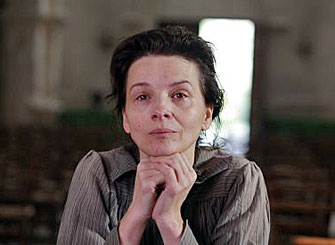
Bruno Dumont’s film Camille Claudel 1915 is one of those movies that critics call “challenging” and “difficult.” It’s one of those films that they give five stars to because they feel guilty about spending their days watching films, and an “extremely serious” film (Screen Daily) makes them feel virtuous (they, too, have to suffer while working!) It’s one of those films that people watch with studied concentration, as if looking close enough will reveal deep hidden meaning no one else has noticed, as if the film had a secret hiding in the shallows of its profundities. In other words, Bruno Dumont’s film Camille Claudel 1915 is one of those film I might politely call a crock of merde.
I only went because a friend was the production designer, and I wanted to see what he’d done, but I did go hoping that there’d be some art in this slice of the arthouse. And there is a strikingly good performance by Juliette Binoche – from the no-makeup-and-closeups-of-blemishes acting school – but sadly, not much point. Juliette as Camille cries and screams and looks longingly into the distance to great effect, but to tell us what? That Camille Claudel was treated extremely badly by her family? That her brother, writer Paul Claudel, was a God-bothering, sanctimonious prig? You don’t have to know much about French art history to know that: Camille Claudel has become a symbol of how men treated women all wrong back then; she’s a real-life, French version of Jane Eyre’s madwoman in the attic. So that there’s nothing in the film’s mindbogglingly long 95 minutes that comes as a surprise is perhaps unsurprising, but that there’s nothing insightful, dramatically interesting or vital about the film either is slightly more disappointing.
Perhaps the film’s only surprise is just how clumsy it is. It’s terribly constructed and narratively inert, as if Dumont just wanted to film Binoche crying for a while and then forgot why. It doesn’t really tell us a story – Camille is unhappy and a bit paranoid at the beginning and still is at the end – and it doesn’t really tell us much about its characters.
Then there is the speech masquerading as dialogue. For the most part, it’s more monologue, awful expository monologues that are there to Explain Things that Dumont can’t be bothered to explain visually or dramatically. You should know you’re in trouble, really, when before the first image of the film there’s text on the screen telling you that the script was drawn from the correspondence and diaries of the two Claudels. It’s like Dumont is getting his excuses in early: They wrote it, not me! To which you just want to reply, Maybe, Bruno, but you didn’t have to film it.
Favorite